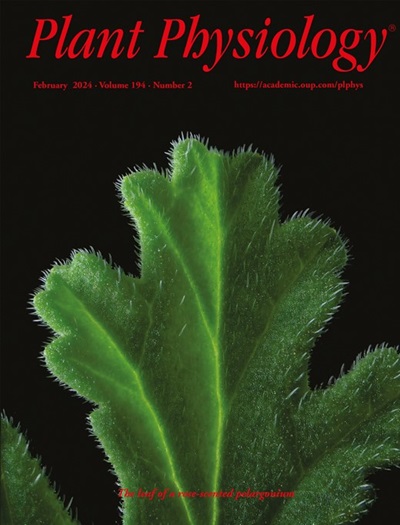转录因子BnaA9。NST3通过光周期途径促进甘蓝型油菜开花
IF 6.5
1区 生物学
Q1 PLANT SCIENCES
引用次数: 0
摘要
开花和次生生长是植物发育过程中两个重要的生物过程,在茎和根的次生生长中,开花与木质部的扩张有着密切的联系。在此,我们报道了NAC次生壁增厚促进因子3 (BnaA9.NST3)的发现,它是木质部纤维细胞次生壁形成的关键调控因子,以光周期途径依赖的方式影响甘蓝型油菜(Brassica napus L.)的开花。我们证明了亚功能化的BnaA9。NST3直接与bac8结合。NF-YC9和Bna。CO启动子调节它们的转录。BnaC8。NF-YC9与Bna相互作用。形成调节Bna的NF-CO复合物。FT转录,从而影响开花。此外,我们还发现花原上调了包括BnaA9在内的次级细胞壁生物发生(SCWB)相关基因。NST3,加速茎部SCWB,促进茎部维管系统的成熟和适应,以满足植物生殖阶段的机械支持需求。我们的研究结果揭示了开花与次生生长之间的联系,并为培养最佳开花时间的甘蓝型油菜品系提供了基因靶点。本文章由计算机程序翻译,如有差异,请以英文原文为准。
The transcription factor BnaA9.NST3 promotes flowering via the photoperiod pathway in Brassica napus L
Flowering and secondary growth are two important biological processes in plant development, and there is a close association between flowering and xylem expansion in stem and root secondary growth. Here, we report the discovery of NAC secondary wall thickening promoting factor 3 (BnaA9.NST3), a key regulator of secondary cell wall formation in xylem fiber cells that affects B. napus (Brassica napus L.) flowering in a photoperiod pathway-dependent manner. We show that the subfunctionalized BnaA9.NST3 directly binds to the BnaC8.NF-YC9 and Bna.CO promoters to regulate their transcription. BnaC8.NF-YC9 interacts with Bna.CO, forming NF‒CO complexes that regulate Bna.FT transcription, thereby affecting flowering. Moreover, we found that florigen upregulated secondary cell wall biogenesis (SCWB)-related genes including BnaA9.NST3, accelerating SCWB in stems and promoting vascular maturation and adaptation of the shoot system to meet the plant’s mechanical support needs during the reproductive phase. Our results provide insights into the connection between flowering and secondary growth and suggest gene targets for cultivating B. napus lines that flower at the optimal time.
求助全文
通过发布文献求助,成功后即可免费获取论文全文。
去求助
来源期刊

Plant Physiology
生物-植物科学
CiteScore
12.20
自引率
5.40%
发文量
535
审稿时长
2.3 months
期刊介绍:
Plant Physiology® is a distinguished and highly respected journal with a rich history dating back to its establishment in 1926. It stands as a leading international publication in the field of plant biology, covering a comprehensive range of topics from the molecular and structural aspects of plant life to systems biology and ecophysiology. Recognized as the most highly cited journal in plant sciences, Plant Physiology® is a testament to its commitment to excellence and the dissemination of groundbreaking research.
As the official publication of the American Society of Plant Biologists, Plant Physiology® upholds rigorous peer-review standards, ensuring that the scientific community receives the highest quality research. The journal releases 12 issues annually, providing a steady stream of new findings and insights to its readership.
 求助内容:
求助内容: 应助结果提醒方式:
应助结果提醒方式:


